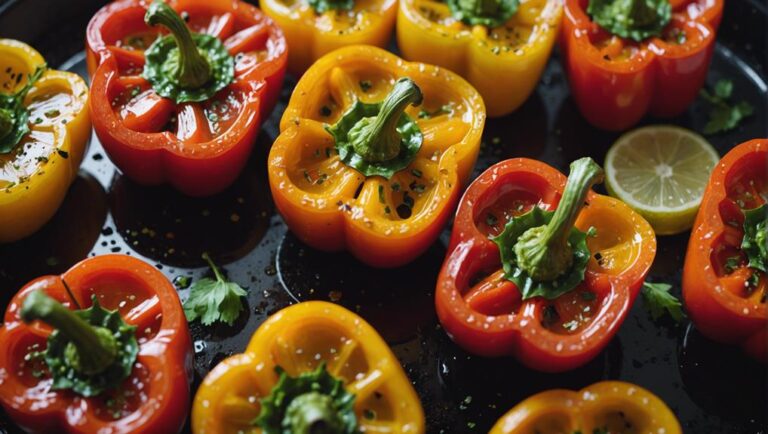Sous Vide Polenta With Olives and Feta
Indulge in the luxurious and flavorful fusion of Sous Vide Polenta with Olives and Feta. Immerse yourself in a Mediterranean-inspired culinary experience that takes the traditional Italian dish to new heights. The creamy polenta, infused with the earthy richness of cornmeal, creates a perfect canvas for the sweet olives and tangy feta to dance on your taste buds. With precision in sous vide cooking at 83°C, achieve the coveted consistency and elevate the dish with a touch of half and half and Parmigiano-Reggiano. Prepare for a vibrant feast that harmonizes Mediterranean ingredients flawlessly.
What You Will Learn Here
- Sous vide method ensures precise temperature control for creamy polenta.
- Olives add a savory Mediterranean twist to traditional polenta.
- Feta cheese provides a tangy contrast to the rich cornmeal base.
- Combination of olives and feta creates a sweet and salty flavor profile.
- Perfect pairing for a complete dining experience with Soave wine.
Polenta's Italian Origins

Italian Polenta has a rich history rooted in the northern regions of Lombardy, Veneto, and Friuli-Venezia Giulia. The traditional dish, made from coarse yellow cornmeal cooked in water, served as a staple for peasants and farmers for its affordability and hearty nature.
Exploring the origins of polenta reveals a culinary journey dating back to Roman times when it was known as 'puls' or 'pulmentum,' highlighting its enduring presence in Italian cuisine.
Italian Polenta Origins
Dating back to Roman times, the origins of polenta can be traced to a time when it served as a staple food for the Roman legions. Made from cornmeal, this hearty dish has strong ties to northern Italy, where it gained popularity for its affordability and versatility.
Initially cooked over an open flame in large copper pots, requiring hours of constant stirring, polenta has evolved into a beloved Italian classic enjoyed in various textures. The influence of the Roman legions on the development of polenta showcases its long-standing presence in Italian culinary history, transforming it from a simple sustenance for soldiers to a versatile and flavorful dish cherished by many today.
Traditional Polenta Dish
Originating in Northern Italy, polenta is a traditional dish crafted from cornmeal, embodying a rich history of peasant cuisine and culinary innovation. To create this iconic dish, cornmeal is slowly cooked in water until it transforms into a creamy and comforting staple. The addition of olive oil and butter infuses the polenta with a luxurious richness, enhancing its flavors and textures. This simple yet versatile dish can be enjoyed soft, akin to a warm porridge, or allowed to cool and solidify for grilling or frying. The table below visually captures the essence of traditional polenta, showcasing its key ingredients and cooking method:
| Ingredients | Water | Olive Oil | Butter |
|---|---|---|---|
| Amount | High | Drizzle | Pat |
Polenta Pairing Suggestions
For an authentic taste of Italy, consider exploring the vibrant flavors that complement polenta in delightful pairings.
The Italian origins of polenta shine through when paired with the briny notes of olives and the tangy richness of feta. The sweet and salty combination adds depth to the creamy texture of polenta, creating a Mediterranean twist that tantalizes the taste buds.
The earthy cornmeal base of polenta serves as the perfect canvas for the robust flavors of olives and feta to meld together harmoniously. This traditional Italian pairing not only reflects a rich culinary heritage but also offers a unique and flavorful experience inspired by the diverse and vibrant cuisine of Italy.
Polenta's Key Flavor Components

Polenta's key flavor components center around a harmonious blend of sweet, tangy, and salty notes, with olives and feta playing pivotal roles in elevating its taste profile. Here's how each element contributes to the dish:
- Sweetness: The corn-based polenta provides a naturally sweet undertone that forms the foundation of the dish, offering a comforting and hearty flavor.
- Tanginess: Feta cheese brings a subtle tanginess that cuts through the richness of the polenta, adding a contrasting yet complementary dimension to each bite.
- Savoriness: Olives introduce a briny and savory kick to the dish, balancing out the sweetness of the polenta and the tang of the feta with their robust flavor.
- Complexity: The combination of olives and feta not only enhances the overall taste profile with Mediterranean influences but also creates a depth of flavor that elevates the polenta into a sophisticated and satisfying dish.
Together, these components create a symphony of flavors that make sous vide polenta with olives and feta a truly memorable culinary experience.
Creamy Polenta Variations
Explore the rich flavors of creamy polenta with variations like Buttery Sage Polenta, Savory Mushroom Polenta, and Herbed Parmesan Polenta.
Each variation offers a unique twist to the traditional dish, elevating its taste and texture.
Whether you prefer a hint of herbaceous notes, earthy mushrooms, or the richness of Parmesan, these creamy polenta variations are sure to tantalize your taste buds.
Buttery Sage Polenta Recipe
Enhance the creamy richness of traditional polenta with the fragrant earthiness of sage-infused butter for a sophisticated and flavorful Buttery Sage Polenta variation. Here's how to elevate your polenta game:
- Infuse Flavor: Add fresh sage leaves to melted butter and let the mixture simmer to allow the sage's essence to infuse into the butter.
- Control the Creaminess: Adjust the amount of butter based on your preference for richness and silkiness in the polenta.
- Balance the Flavors: The combination of sage and butter should complement the cornmeal base without overpowering it.
- Serve with Style: Garnish your Buttery Sage Polenta with a sprinkle of Parmesan cheese and a drizzle of extra-virgin olive oil for a luxurious finish.
Savory Mushroom Polenta Recipe
Elevate your culinary repertoire with a luscious and savory Mushroom Polenta recipe that marries the earthy richness of mushrooms with the velvety smoothness of creamy polenta. Here's why this dish will become a favorite in your kitchen:
- Umami Burst: The savory mushroom polenta delivers a delightful umami punch, thanks to the flavorful mushrooms blended into the creamy texture.
- Versatile Delight: Whether as a side dish or the star of the show, this polenta variation complements various proteins, making it a versatile choice for any meal.
- Depth of Flavor: The addition of high-quality mushrooms and well-balanced seasoning creates a dish with a depth of flavor that will satisfy even the most discerning palates.
- Satisfying Experience: Each bite of this savory mushroom polenta offers a satisfying experience that will have you coming back for more.
Herbed Parmesan Polenta Recipe
Indulge in the luxurious creaminess and robust flavors of Herbed Parmesan Polenta, a delectable variation that will elevate your dining experience. This creamy and flavorful polenta recipe combines the richness of Parmesan cheese with the aromatic essence of herbs, creating a dish that's both comforting and sophisticated.
Here are four reasons why Herbed Parmesan Polenta is a must-try:
- The blend of herbs and Parmesan cheese adds layers of complexity to the creamy polenta, enhancing its overall taste.
- The texture of this polenta is velvety smooth, making each bite a delightful experience.
- Herbed Parmesan Polenta can be served in various forms, including as a creamy side dish or molded into polenta cakes for a crispy exterior.
- The combination of herbs, Parmesan, and polenta results in a dish that's both hearty and satisfying, perfect for any occasion.
Polenta Consistency Secrets
To perfect the texture of your polenta, pay close attention to these consistency secrets. Massaging the bag during sous vide cooking is essential for uniform hydration and a silky smooth result.
Traditional stovetop methods may fall short in achieving the desired consistency, making sous vide an excellent choice for precise control over the texture.
Creamy Polenta Tips
For a luxuriously creamy polenta that melts in your mouth, consider blending broth and water in equal parts as the cooking liquid. Incorporate butter and salt while cooking sous vide to enrich the flavors. The addition of Parmesan towards the end of the cooking process can enhance the creaminess and taste of the polenta. Massaging the bag during cooking guarantees a consistent and smooth texture. To further enhance the creaminess and depth of flavor, adding grated cheese like feta can be a game-changer. The olives in the polenta provide a savory twist, complementing the creamy texture with a burst of unique flavor. Experimenting with these tips will result in a decadent polenta dish that pleases your taste buds.
| Secrets for Creamy Polenta | ||
|---|---|---|
| 1. Blend broth and water in equal parts | 2. Incorporate butter and salt | 3. Add Parmesan towards the end |
| 4. Massage the bag for consistency | 5. Enhance with feta and olives |
Perfecting Polenta Texture
To achieve the perfect polenta consistency, meticulously controlling the liquid absorption rate and maintaining a consistent stirring technique are paramount for ensuring a smooth and velvety texture. Proper hydration of the cornmeal is essential to achieve a creamy consistency.
The cornmeal needs to absorb the liquid gradually to prevent clumps from forming. Consistent stirring throughout the cooking process is vital to evenly distribute the moisture and prevent any lumps from developing. By maintaining a steady stirring motion, you help the cornmeal hydrate uniformly, resulting in a silky texture.
Consistency Secrets Revealed
Achieve the coveted consistency of perfect polenta by uncovering the hidden secrets to maintaining its texture and hydration levels. When cooking polenta sous vide, precision is key. Set your sous vide machine to 83°C for consistent results.
To guarantee a smooth texture, gently massage the cooking bag during the process. For added creaminess, incorporate half and half and Parmigiano-Reggiano after cooking. These steps help lock in moisture and maintain uniformity, resulting in a delectably smooth and flavorful polenta.
Following these consistency secrets revealed, your polenta will impress with its perfect texture and rich taste, elevating your dish to gourmet levels. Mastering these techniques will make your sous vide polenta a standout favorite.
Final Thoughts
In reflecting on the vibrant flavors and textures of this sous vide polenta dish, one can truly appreciate the harmonious blend of Mediterranean ingredients. The incorporation of sweet olives and tangy feta cheese creates a symphony of flavors that dance on your taste buds, elevating a simple polenta dish to a gourmet experience. The fool-proof polenta, enriched with Parmesan, provides a creamy and velvety base that perfectly complements the crispy exterior achieved through sous vide cooking.
As you savor each bite, the contrasting textures of the creamy polenta, the briny olives, and the crumbly feta cheese create a delightful sensation in your mouth. The versatility of this dish allows you to pair it with a variety of proteins and vegetables, making it a go-to option for any meal. To truly transport yourself to the shores of the Mediterranean, enjoy this dish with a glass of Soave wine, enhancing the overall dining experience. Sous vide polenta with olives and feta is a culinary journey not to be missed, offering a perfect balance of flavors and textures that will leave you craving more.
Frequently Asked Questions
How Do Italians Serve Polenta?
Italians serve polenta in various ways, including traditional toppings like rich sauces or roasted vegetables. They use cooking methods such as grilling, frying, or baking. Regional variations showcase polenta with mushrooms, sausages, and ragù for a comforting meal.
Is Polenta Better With Milk or Water?
For a creamy texture, choose milk in polenta; it enhances richness. Water highlights corn flavor. Milk adds sweetness, complementing savory dishes. Water offers a clean base. Your preference determines the flavor profile – milk for richness or water for a natural taste.
What's the Difference Between Cornmeal and Polenta?
When differentiating between cornmeal and polenta, note that the distinction lies in the preparation and culinary application. Cornmeal is a versatile ingredient ground from corn, while polenta specifically refers to the creamy dish cooked from cornmeal.
Should Polenta Be Soaked Before Cooking?
You should soak polenta before cooking for improved texture and flavor infusion. It's a common technique, enhancing creaminess and taste. Soaking in broth or milk elevates the dish. While not mandatory, it's a culinary choice for a richer outcome.
Conclusion
Indulge in the rich and creamy goodness of sous vide polenta with olives and feta. The Italian origins of polenta bring a touch of tradition to this dish, while the combination of flavors from the olives and feta adds a unique twist.
Experiment with different variations to achieve the perfect consistency, and savor each bite of this delectable dish. Elevate your culinary skills with this simple yet impressive recipe.
Bon appétit!











